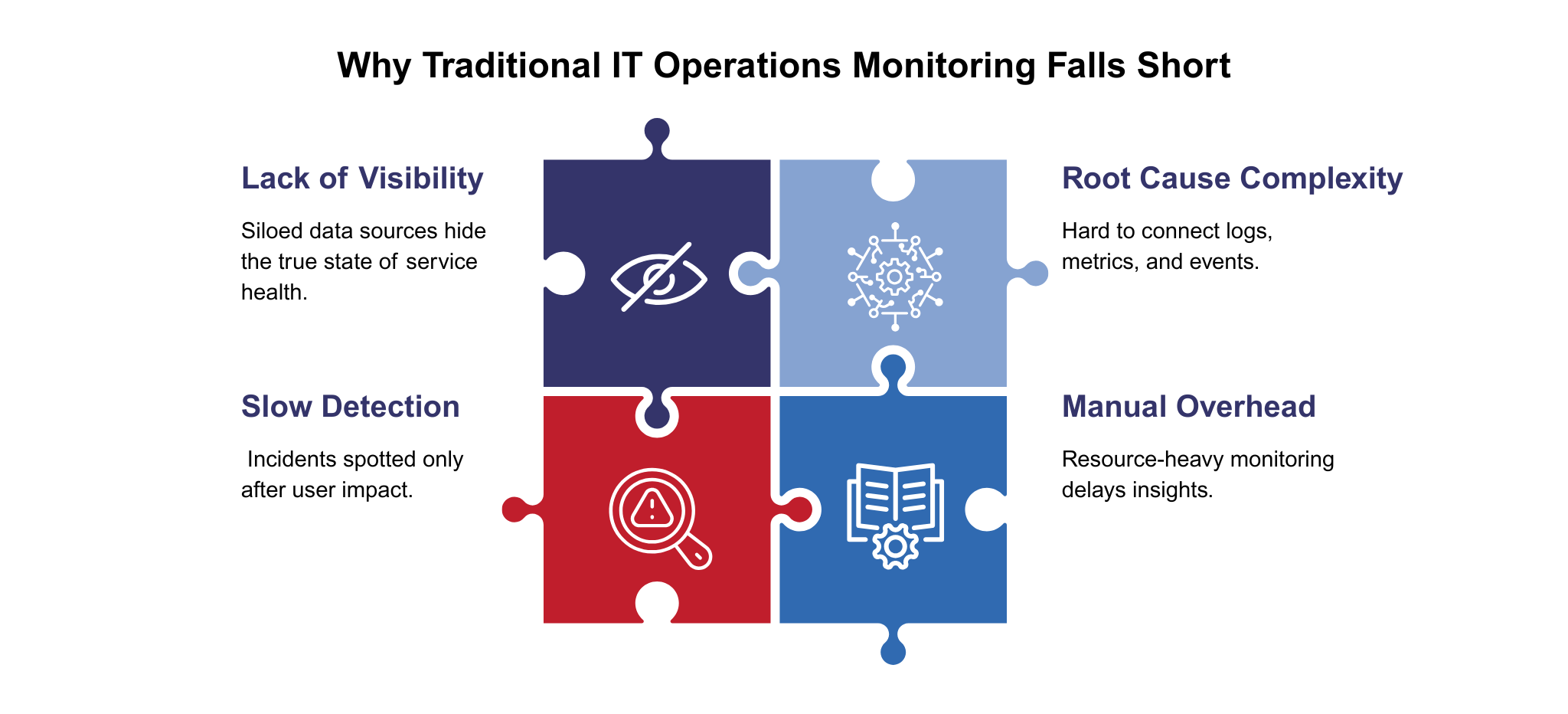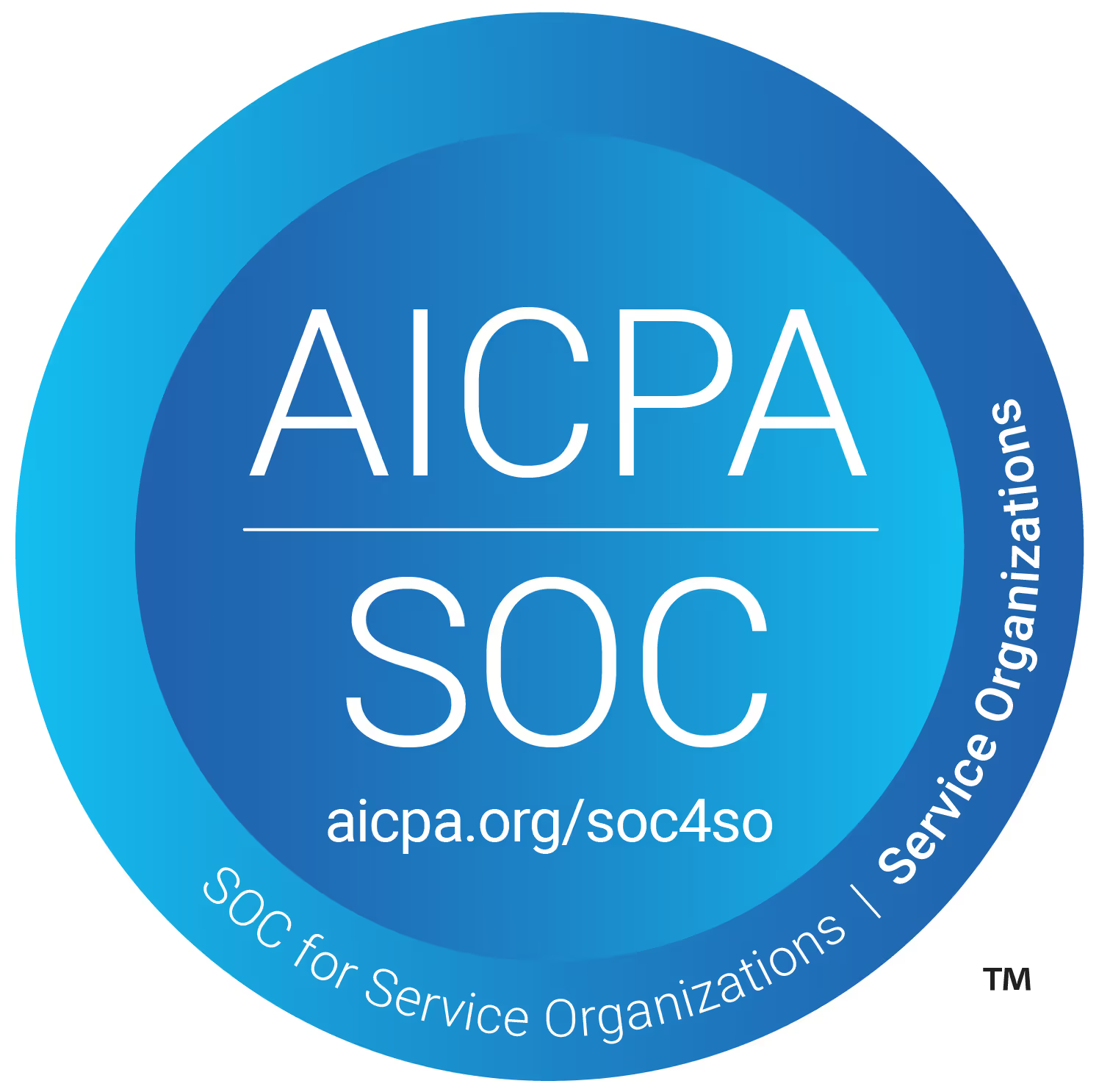Summarize the Content of the Blog
Key Takeaways
- Splunk IT Service Intelligence (ITSI) provides AI-driven monitoring and KPI-based service health scoring for proactive IT operations.
- With ITSI predictive analytics and KPI drift detection, enterprises can spot early warning signs of service degradation, reduce downtime, and accelerate incident resolution.
- AI-powered ITSI incident management reduces manual effort, allowing IT teams to focus on strategy rather than firefighting.
- Splunk ITSI vs Observability Cloud: both complement each other, delivering unified monitoring across hybrid and cloud-native environments.
- Partnering with experts like bitsIO ensures successful Splunk ITSI implementation, tailored KPIs, and optimized service insights.
Why IT Service Intelligence Is Critical in 2025
By 2028, the AIOps platform market is expected to reach $32.4 billion, more than double its size in 2023. This growth reflects the skyrocketing complexity of IT environments, as hybrid clouds, microservices, containers, and distributed services have become the norm. As these systems expand, so do the data volumes they generate, often overwhelming even the most advanced monitoring setups.
To keep pace, enterprises must evolve their approach to data. Traditional tools can’t keep up with the scale, speed, or diversity of machine data. That’s why Gartner predicts that by 2025, 70% of organizations will shift their focus from “big data” to “small and wide data”: compact, context-rich datasets that make AI faster, more efficient, and less dependent on sheer volume.
In this environment, precision and context become essential, that is, not just knowing what happened, but understanding why.
This is where Splunk IT Service Intelligence (ITSI) steps in. ITSI brings together service-centric monitoring, machine learning, and predictive analytics to help IT teams answer two fundamental questions with confidence:
- Is my service healthy?
- If not, what’s the root cause?
In this blog, we’ll explore how IT leaders can use Splunk ITSI to gain full-stack visibility, implement predictive IT operations, and elevate incident response. You’ll also learn how ITSI works in tandem with Splunk Observability Cloud to create a unified view across hybrid and multi-cloud environments.

How Splunk ITSI Improves Service Visibility and Incident Response
Splunk IT Service Intelligence helps IT teams monitor complex environments with more context and clarity. Instead of sifting through raw data, teams can focus on meaningful insights tied directly to service health and business performance.
- Monitor What Matters with KPI-Based Health Scores
ITSI KPI tracking lets teams define health scores for business services, like payment systems or customer portals. This shifts the focus from server uptime to service-level impact, making monitoring more relevant and actionable.
- Accelerate Root Cause Analysis
By correlating events across logs, metrics, and alerts, ITSI highlights likely root causes within seconds. This reduces noise, shortens triage time, and removes much of the guesswork from incident investigations.
- Prevent Issues with Predictive Analytics
Machine learning in ITSI detects patterns that suggest potential future issues, such as resource strain or hardware failure. Teams can resolve issues before users are impacted, enhancing service uptime and reliability.
- Streamline Response with AI-Driven Workflows
ITSI enhances incident management by filtering false positives and automating responses. This reduces the mean time to detect (MTTD) and mean time to resolve (MTTR), helping teams stay ahead of disruptions.
With these capabilities, Splunk ITSI monitoring ensures IT operations evolve from reactive firefighting to proactive, business-aligned resilience.
Now that we’ve seen how ITSI transforms monitoring, let’s explore the best practices for Splunk ITSI implementation that ensure maximum impact.
Best Practices for Splunk ITSI Implementation
To maximize ROI from Splunk ITSI implementation, enterprises should:
- Define Business-Centric KPIs Early: Align service health scores with business goals, not just technical metrics.
- Automate Event Correlation: Leverage ITSI’s correlation searches to minimize alert fatigue and highlight only actionable insights.
- Adopt Iterative Optimization: Continuously refine KPIs, thresholds, and predictive models as services evolve.
- Align with Compliance: In regulated industries, ensure dashboards and reports are audit-ready as part of ITSI deployment.
These practices transform ITSI from a monitoring tool into a predictive, business-aligned platform. At bitsIO, we understand this and implement Splunk ITSI best practices to ensure our clients achieve maximum value, scalability, and resilience from day one.
While ITSI streamlines service health monitoring and proactive analytics, many leaders still wonder how it fits alongside Splunk Observability Cloud. Let's break down how Splunk ITSI vs Splunk Observability Cloud complement each other, and why enterprises get the best results when both are integrated — as opposed to traditional approaches.
Comparing Traditional Monitoring, Splunk ITSI, and Observability Cloud
Modern IT operations require more than just uptime tracking. They demand deep visibility, real-time responsiveness, and alignment with business outcomes. Here's how traditional tools compare to Splunk ITSI and Observability Cloud, and why a unified approach delivers the most value:
By combining Splunk ITSI’s KPI-based service health monitoring with Observability Cloud’s deep application insights, enterprises gain a hybrid monitoring ecosystem that covers both macro-level services and micro-level performance. This integration reduces downtime, speeds up triage, and ensures IT actions are always aligned with business priorities.
Together, Splunk ITSI and Splunk Observability Cloud provide a holistic monitoring ecosystem. ITSI ensures IT operations teams can track business-critical services with predictive insights, while Observability Cloud captures the granular, real-time performance of cloud-native apps. This hybrid monitoring model enables organizations to reduce downtime, accelerate troubleshooting, and align IT health with business outcomes.
Why the Right Splunk ITSI Partner Matters
Success with ITSI depends on aligning KPIs with business services, tuning predictive analytics, and embedding intelligent alerting into day-to-day operations. Without the right partner, organizations risk underutilizing ITSI’s full potential.
At bitsIO, our team of Splunk-certified consultants brings deep expertise in:
- End-to-end Splunk ITSI implementation tailored to business-critical KPIs and service health scoring.
- Predictive analytics and anomaly detection that help forecast service degradations before they impact users.
- Intelligent alert management through episode tuning to cut alert noise by up to 95% and surface what truly matters.
- ITSI workflow and ITSM integrations, enabling automated ticketing, on-call routing, and faster remediation.
- Continuous optimization and compliance-ready deployments to support PCI-DSS, HIPAA, SOX, and hybrid environments.
By partnering with bitsIO, enterprises turn Splunk ITSI into a business enabler.
Conclusion
Splunk IT Service Intelligence empowers IT leaders to move beyond reactive monitoring and embrace predictive, AI-driven operations. By leveraging KPI-based service health scores, intelligent event correlation, and advanced ITSI predictive analytics, organizations can detect risks earlier, accelerate resolution, and reduce costly downtime. ITSI ensures that IT systems not only support business operations but also actively drive resilience, performance, and growth.
With the right partner, ITSI evolves into the backbone of AI-enhanced IT operations, capable of scaling seamlessly with your enterprise needs.
At bitsIO, we specialize in helping enterprises unlock the full value of ITSI. Our Splunk-certified consultants bring deep expertise in service modeling, predictive analytics, workflow automation, and compliance-ready implementations. Whether you’re optimizing existing deployments or starting fresh, we ensure your ITSI journey delivers measurable business outcomes.















